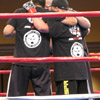Millennia
MMA Training Center
8423 Rochester Ave. Suite #102, Rancho Cucamonga, CA 91730.
Millennia was established a decade ago by Romie Aram, John Jensen, and Javier Vazquez of Southern California. This well structured MMA training camp is one of California's most respected MMA training facilities and home to fighters like UFC Veteran & Brazilian Jiu-Jitsu Black Belt Romie Aram, Brazilian Jiu-Jitsu Black Belt Betiss Mansouri, Brazilian Jiu-Jitsu Black Belt and Lightweight Champion Javier "Showtime" Vazquez, Manny "The Mangler" Tapia, Victor "Joe Boxer" Valenzuela and World Muay Thai Champion William "The Bull" Sriyapai. Along with many other top Millennia fighters!
This fully equipped gym has instructors who specialize in everything from Brazilian Jiu-Jitsu and Kickboxing, to free style Wrestling and Muay Thai.
Victor Valenzuela
Nick Name Joe Boxer
Weight 155lbs (70kg)
Country USA
Record 6 - 2 - 2 (Win - Loss - Draw)
Wins 2 (T)KOs (33.33%)
4 Submissions (66.67%)
Losses 1 Submissions (50.00%)
1 Decisions (50.00%)
Facts about Joe Boxer
Victor Valenzuela aka “Joe Boxer” started his career by training with the Millennia Fight Team.
• Has never been knocked out.
• 40% of his wins have come via knockout.
• Last three wins ended in the first round.
• First career win was against Tim Cree via Knocked out in just 0:12 into round one during King of the Cage "The Return" (3/19/06); first submission win came against Juan Rivas on a California Xtreme Fighting card when Rivas tapped out to an armbar at 2:17 in the second round; Knocked out Toby Greer at CXF 4 (10/17/06) at 2:26 of the first round; submitted Albert Hill with an armbar at 1:01 of the first round at King of the Cage "Caged Chaos" (3/10/07); most recent win was a submission victory via rear naked choke over Scott Ayres at 0:30 in the first round during King of the Cage "Sinister" (4/27/07).
Mac Danzig
Record 18 - 4 - 1 (Win - Loss - Draw)
Wins 4 (T)KOs (22.22%)
10 Submissions (55.56%)
4 Decisions (22.22%)
Losses 1 (T)KOs (25.00%)
3 Decisions (75.00%)
Weight 155lbs (70kg)
Birth Date 1-2-1980
City Los Angeles
State California
Mac Danzig is an professional mixed martial arts fighter and instructor, and is a former lightweight champion. Danzig was born in Cleveland Ohio on January 2, 1980 and is currently under contract with the UFC.
Manny "The Mangler" Tapia
Manny "The Mangler" Tapia is a professional mixed martial arts fighter who was born in Riverside California and now trains in Chino. Tapia is also owner and instructor of the Millennia MMA training center now located in Rancho Cucamonga, CA.
Height 5′ 8″ (172.72 cm)
Weight 151 (68.49 kg)
Fighting style Jiu-Jitsu
Mixed martial arts record
Wins 10
By knockout 4
By submission 2
Losses 0
Draws 1
Name Manny Tapia
Nick Name The Mangler
Record 10 - 0 - 1 (Win - Loss - Draw)
Association Millenia Jiu-Jitsu
Height
Weight 135lbs (61kg)
The History Of Mixed Martial Arts.
By. S.A
The Greeks in 648 B.C.E. Intorduced the sport of Pankration into the Olympic Games. Pankration is a combination of two Greek words, pan, meaning “all,” and kratos, meaning “powers.” This is a depiction of the sport, as it was a mixture of wrestling and Hellenic boxing. The sport only truly had two rules: no biting and no eye gouging, though even these techniques were allowed by the Spartans. The bouts ended only when one competitor was knocked unconscious, or by submission to the opponent by raising his hand.These matches would last for hours, and would sometimes end with the death of one competitor. The sport was the most popular event in the Olympic Games and within the Hellenic world.
The matches took place in “ring” which was a 12 to 14 feet square, which the Greeks created to encourage close-quarter combat. The matches featured a referee armed with a rod he used to enforce the fighting rules. Techniques included punches, joint locks, choke holds, elbow and knee strikes, and kicks. Kicks to the legs, groin and stomach were commonly used. The majority of pankration bouts were settled on the ground, where submission holds and strikes were both accepted. Pankratiasts were renowned for their grappling skills, and would employ a variety of grappling techniques, such as chokes & joint locks and take downs. The most common cause of death in pankration matches was strangulation.
Ancient Greek pankratiasts became heroes, and eventually the subject of many myths and legends. Which included the legends of Arrichion, Dioxxipus, Polydamos and Hercules. Alexander the Great used pankratiasts as soldiers because of their skills at unarmed combat. When Alexander the great invaded India in 326 B.C.E., he had a large number of Pankratiast soldiers in his army. This is considered to be the beginning of Asian martial arts. Manny Asian martial arts trace their history to India during this time. Pankration is the first recorded form of what would later become known as mixed martial arts.
After the decline of pankration in Greece, and the upcoming of the Roman Empire, mixed martial arts popularity fell and other sports like wrestling and boxing became the dominant forms of combat. In Asia, however mixed martial arts dominated the sports arena. For centuries this remained the cas until in 1925 in Rio de Janeiro, Brazil, mixed martial arts was revived.
The Gracie Family Legacy
In 1801 George Gracie immigrated to Brazil from Scotland settling in northeastern Brazil Para province. His family grew prosperous in the early 1900s. During this time a Japanese man named Mitsuyo Maeda immigrated to the same are. Mitsuyo was a renowned champion of judo and known as Count Koma in Japan. He offered to teach Carlos the great grandsonof George Gracie the Japanese martial arts
The Gracie brothers were not bound by the tradition that Japanese practitioners of the art instead the brothers began to adapt the art to suit themselves. As the Gracies continued to perfect their art in their new academy, Carlos Cracie created a plan to to draw attention to the academy. He created what is now famously known as the “Gracie Challenge.” As he stated,“If you want a broken arm, or rib, contact Carlos Gracie at this number.” This began the revival of professional mixed martial arts in the Western world. The matches resembled the pankration matches of Ancient Greece. The Gracies fought representatives of area karate schools, professional boxers, capoeira champions, and various other fighters to prove themselves creating what is known today as Gracie jiu-jitsu
As these matches became more popular through Rio de Janeiro, the public craved these matches. These matches began to be held in Brazil’s large soccer stadiums, and attracted record crowds. The first of these professional fights was between Brazilian Lightweight Boxing Champion, Antonio Portugal and Carlos’ younger, smaller, and much frailer brother Helio. Helio won the match in less than 30 seconds, effectively elevating himself to the status of Brazilian hero.
Japanese champions came to Rio de Janeiro to fight with Helio Gracie, who was always out weighed by his opponents sometimes by more than than 100 pounds. He defeated many great Japanese fighters, and eventually the United States World Freestyle Wrestling Champion super heavyweight Fred Ebert. One-hundred-thirty-five pound Helio continued to defend the Gracie name and their martial art from 1935 until 1951 fighthing over 1000 fights. Later Carlos’ son, Carlson, and Helio’s sons Rolls, Rickson and Rorion took over the roll of family champion in upholding the “Gracie Challenge.”
The new combat sport of Brazilian jiu-jitsu fighting became immensely popular, quickly rising to become the second most popular sport, in Brazil behind soccer. The fights featured practitioners of Brazilian jiu-jitsu, muay Thai kickboxing, luta livre wrestling, boxing and various other styles. As a result, Brazilian jiu-jitsu, grew in in Brazil.
The History of Ultimate Fighting Championships
UFC
By S.A.
In the early 1980s, Helio’s Gracie oldest son Rorion, came to the United States to teach Brazilian jiu-jitusu or Gracie jiu-jitsu as he preferred to call it in California. Just like his father and uncle before him, he continued the infamous “Gracie Challenge”. This time Rorion offered $100,000 to anyone who could defeat him or his brothers. As Rorion realized the potential his family's art he decided to create an organization that would promote Brazilian jiu-jitsu.
Rorion Gracie met Art Davie, a businessman who had first become interested in jiu-jitsu during a trip he took to Thailand. He witnessed an underground mixed martial arts fight. Davie used his connections in the entertainment industry to set up an agreement meeting for himself and Rorion Gracie with Bob Meyrowitz president of Semaphore Entertainment Group (SEG). SEG a corporation that specialized in putting on live pay-per-view sports events. In 1993 the three men created the “Ultimate Fighting Championship". The first “Ultimate Fighting Championship” event sold 86,000 pay-per-view buys. The third third event sold up to 300,000 pay-per-view buys per event. This created a place for the sport of mixed martial arts in the United States.
The Ultimate Fighting Championship (UFC) had started a form of fighting which it known as “no-holds-barred,” or NHB fighting. The first six Ultimate Fighting Championships had limited. There were time limites or rounds, no weight classes, and no mandatory safety equipment. The only rules were no eye gougeing, bite, or fish hook. Fights could only end with a referee’s stopping it until a knock out, submission took place (tap out). The event took place in an octagonal cage, which is no known as “The Octagon.”
Competitors would fight several bouts in one night, in an elimination style tournament until there was only one champion. There were no weight classes which became a problem. A 415 pound Hawaiian sumo wrestler was allowed to fight 216 pound Dutch kick boxer Gerard Gordeau. Later a similar fight took place when 6-foot-8inch tall, 600 pound sumo wrestler from New Jersey, Emmanuel Yarborough, fought Keith Hackney 5-foot-11-inch tall, 200 pound karate fighter.
As a result of competitors learning Royce Gracie's fighting techniques, the lack of time limits became a problem. The fights became longer and longer. The fights were running over the pay-per-view time slots and the UFC was losing fans because they viewed the long periods of ground fighting as boring. SEG realized this, so in 1995, at UFC instituted a 30 minute time limit. When Royce Gracie-Ken Shamrock rematch ran over the 30 minute time limit, it was ruled a draw. Outraged fans demamed an answer resulting in the use of judges beginning with UFC VI to decide the outcome of fights that lasted longer.
UFC creates a political uproar topic.
To draw attention UFC was marketed as a blood sport witn "no rules" or "no-holds-barred" fighting. UFC was marketed as a blood sport where anything could happen even death. This is when Arizona Senator / presidential candidate John McCain launched a campaign against the UFC. Because of this in 1997, pay-per-view carriers dropped the Ultimate Fighting Championship events. Senator McCain became an outspoken apponent of the abolition of the sport, mixed martial arts was outlawed in most states. The UFC moved its events from state to state, until the pay-per-view providers dropped the events.
“Mixed martial arts training is the hardest thing I have ever done in my life"
FormerUFC heavyweight champion Tim Sylvia says “Mixed martial arts training is the hardest thing I have ever done in my life,” and UFC light-heavyweight contender Chuck Liddell stated that mixed martial arts training is “more rigorous training than almost any other sport.” The new breed of fighters are former NCAA champions, Olympic medallists, Pan American game medallists, boxing champions, and NFL players. Fighers spend 5-6 years fighting in smaller events building their resumes. Mixed martial arts is the fastest growing sport in the United States.
The new breed are well-rounded fighters, versed in numerous styles of combat, and equally at home on the mat, as standing and trading punches and kicks. Among the new breed of fighters are former Olympic medallists, NCAA champions, Pan American games medallists, and even a long list of former NFL football players, and boxing champions. Many of these fighters are college graduates, and several are graduate school students.
Millennia
MMA Training Center
8423 Rochester Ave. Suite #102, Rancho Cucamonga, CA 91730.
Millennia was established a decade ago by Romie Aram, John Jensen, and Javier Vazquez of Southern California. This well structured MMA training camp is one of California's most respected and home to fighters like UFC Veteran & Brazilian Jiu-Jitsu Black Belt Romie Aram, Brazilian Jiu-Jitsu Black Belt Betiss Mansouri, Brazilian Jiu-Jitsu Black Belt and Lightweight Champion Javier "Showtime" Vazquez, and World Muay Thai Champion William "The Bull" Sriyapai. Along with many other top Millennia fighters!
This fully equipped gym has instructors who specialize in everything from Brazilian Jiu-Jitsu and Kickboxing, to free style Wrestling and Muay Thai.
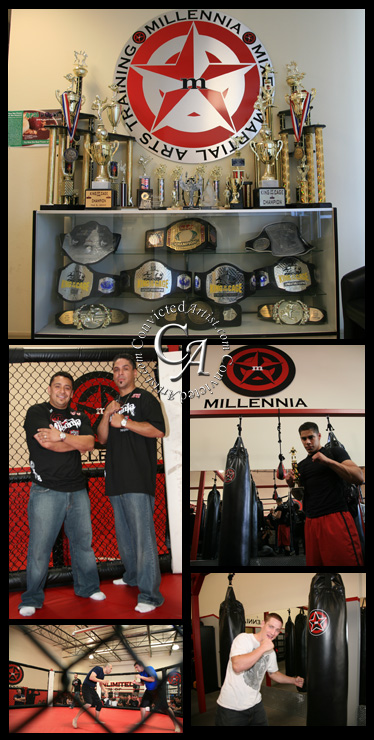
Millennia was established a decade ago by Romie Aram, John Jensen, and Javier Vazquez of Southern California.

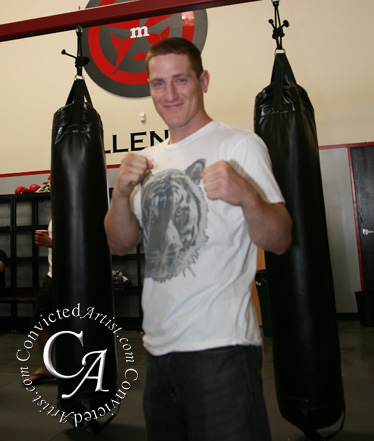
Mac Danzig is an professional mixed martial arts fighter and instructor, and is a former lightweight champion.
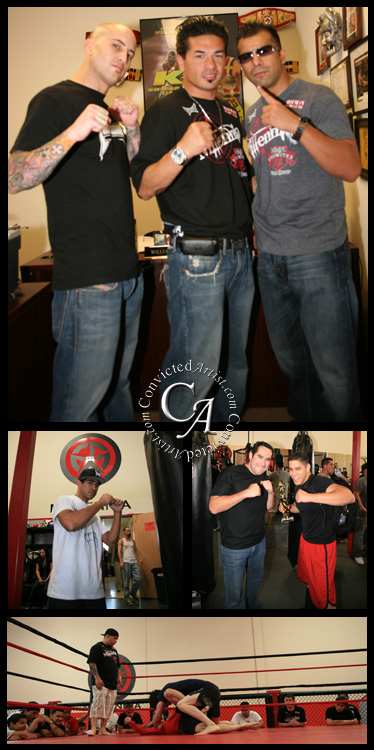
Manny "The Mangler" Tapia is a professional mixed martial arts fighter who was born in Riverside California and now trains in Chino.
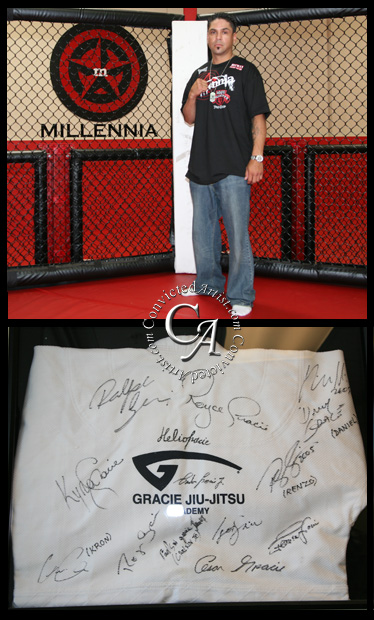
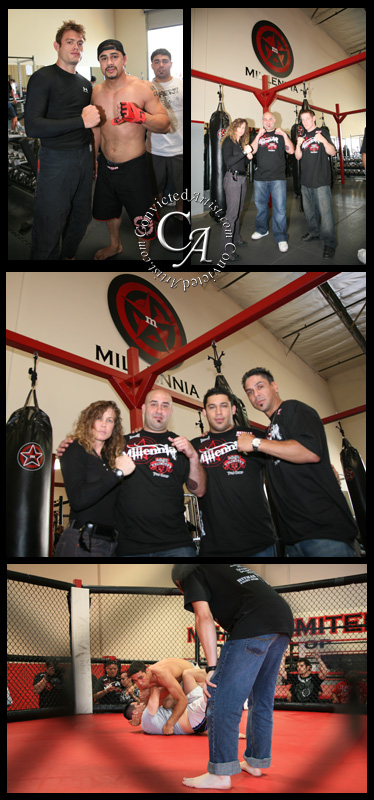
Video of Brazilian Jiu-Jitsu Black Belt Betiss "Super" Mansouri in action.


